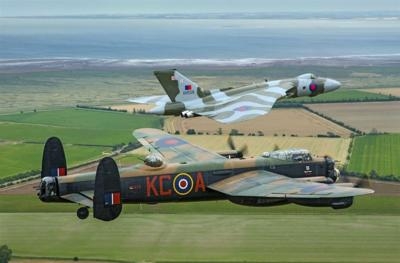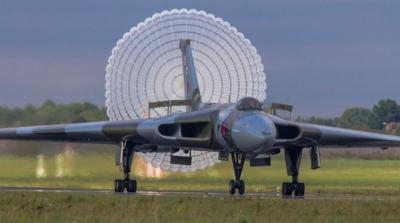Exciting New Display Planned To Celebrate Final Flying Year Plus National Tours And Events
One of the world’s most popular aircraft, Vulcan XH558, the last airworthy example of Great Britain’s famous V-Force and a powerful reminder of a remarkable period in British history, is about to begin her last flying season. To celebrate this remarkable aircraft in her final flying year, the aircrew, led by Martin Withers (who captained Vulcan XM607 on the famous Black Buck mission during the Falklands Conflict) is about to launch a dramatic new display routine and other exciting events across the country.

Returned to the skies in 2007 following what is now believed to be the most ambitious heritage aircraft restoration programme ever undertaken, Vulcan XH558 is operated to amongst the world’s most demanding safety standards. Each year, charity Vulcan to the Sky Trust raises more than £2 million to service and operate the aircraft, which is based at the former RAF Finningley, now Robin Hood Airport Doncaster Sheffield.
The charity’s chief executive, Dr. Robert Pleming, told supporters; “If you don’t see her this season, there will be no more opportunities to hear a Vulcan’s spine-tingling howl as she climbs high into the sky for another memorable display, or to see her rolling onto her side to reveal her giant delta silhouette.”
The new display will be revealed for the first time at the Throgmorton Airshow on June 6th followed by a packed calendar of appearances that will take her to more people than ever before. National tours are planned to celebrate related British engineering achievements and to salute the heroes of Britain’s legendary V-Force in which she played a vital role during the knife-edge tension of the Cold War. The V-Force Tour is currently scheduled to overfly the remaining ground-based V-Force aircraft in southern England on June 27 and in northern England on June 28.
“We will be flying selected items in the aircraft so that as many of her supporters as possible can purchase something that has taken part in this adventure,” said Pleming. “I would like to thank everyone who has donated their time and/or money to help XH558 fly, including of course the many specialist companies whose expertise has been invaluable. The pleasure she brings to millions of people each year would not have been possible without you all.” All money raised will be used to operate XH558 this summer and to continue to maintain her in fast-taxi condition when she stops flying.
When XH558 lands for the last time at the end of a spectacular Farwell to Flight season, it will be to become the center of a new type of education initiative. “XH558 is an iconic example of that remarkable period of intense post-war innovation that made British aviation technology the envy of the world,” concludes Pleming. “In her new life, still able to accelerate dramatically along the runway, XH558 will build on this exciting provenance to inspire and educate new generations of young people, helping to deliver the technical and aviation skills that Britain so badly needs.”
There will also be a heritage center so that enthusiasts can continue to visit the aircraft and learn about the engineering innovation and Cold War politics that brought her into existence. XH558 will be maintained to a high standard and will regularly thrill audiences with her famous Vulcan howl as she accelerates along the runway.
Already around 15,000 people a year visit XH558 at her hangar. The award-winning tours must be booked in advance (for security reasons there is no access without pre-booking) and can be chosen by visiting www.vulcantothesky.org and clicking displays/tours.

Having evaluated a great many factors, the three expert companies on whom XH558 depends – known as the ‘technical authorities’ - have together decided to cease their support at the end of this flying season. Without that support, under Civil Aviation Authority regulations, she is prohibited from flying. “This is for entirely pragmatic and well-argued reasons related to the age of her airframe and engines and the growing difficulty sourcing otherwise redundant skills,” explains engineering director Andrew Edmondson. “I cannot emphasise highly enough that this is not in any way a comment on XH558’s safety this year. She has proven to be as reliable as most modern military jets and is maintained to the CAA’s rigorous standards which are amongst the highest in the world.”
At the heart of their decision are two factors. First, although XH558 is currently as safe as any aircraft flying today, her structure and systems are already more than ten percent beyond the flying hours of any other Vulcan, so knowing where to look for any possible failure will become more difficult. Second, maintaining her superb safety record requires expertise that is increasingly difficult to find. “Our technical partners already bring specialists out of retirement specifically to work on XH558; a solution that is increasingly impractical for those businesses as the necessary skills become distant in their collective memories,” explains Edmondson. “We have recently been made aware that the skills issue is particularly acute as our engines age and will require a considerable amount of additional (and costly) inspection and assessment.”
The Trust has worked hard to see if another year may be possible. Unfortunately, following extensive discussion with the technical authorities, some of the challenges have proven to be insurmountable.

The Avro Vulcan is a powerful example of British aerospace engineering at its world-beating best. The design brief was issued by the MoD in 1946 and the aircraft flew for the first time on August 30th 1952, just eleven years after the first flight of its predecessor, the Avro Lancaster. Its impressive list of technical achievements includes being the first successful large delta wing aircraft (leading directly to Concorde), innovations such as electrically-powered flying controls, one of the first applications of anti-lock brakes (similar to those on the Jensen FF) and a speed and agility that was so close to a jet fighter’s that it was given a fighter-style control column in place of the traditional bomber pilot’s yoke.
Success as a Cold War peacekeeper meant that the Vulcan might have flown its entire service life without ever entering combat if it hadn’t been for the Falklands Conflict in 1982. During a marathon 8,000 mile flight supported by eleven Victor tankers, Martin Withers and his crew released the bombs over Port Stanley Airport that prevented Argentina operating its Mirage III fighters from the island and initiated the campaign that recaptured the Falklands. Two years later, the last Vulcans were withdrawn from service. Martin earned a Distinguished Flying Cross for his part in this action.
Today, only one Vulcan is left flying: XH558, owned by Vulcan To The Sky Trust, a registered charity. The airplane returned to the air in 2007 following one of the world’s most challenging restoration programs, she has become an airshow phenomenon. “People forget that airshows attract seven million people annually. As a spectator activity, that’s second only to football,” says Dr Pleming.
Martin Withers DFC, now Vulcan to the Sky Trust’s operations director and chief pilot, is a passionate supporter of the educational role of the aircraft. “Part of our mission is to ensure that young people learn about the knife-edge fear of the Cold War,” he explains. “If I had been ordered to press the button that releases the nuclear payload over our enemy, there would almost certainly have been no Britain left to fly home to. The Vulcan is the most powerful symbol of a remarkable period in global history that we must never forget.”

Withers is also highlights the aircraft’s growing role in technical education, a field that will become her focus when she can no longer fly. “The Vulcan is one of the most significant steps forward in aerospace technology, and it is thoroughly British. She fires young people with a passion for engineering and innovation, which we can build on using the extraordinary energy and expertise needed to restore and operate the UK’s only flying ‘complex’ heritage aircraft to world-class safety standards.” When the combination of age and complexity of the aircraft eventually prevents further renewal of her Permit to Fly, she will form the heart of a new type of engineering education initiative that will continue to inspire young people with a passion for science and technology.
(Images by Eric Coekelbergh provided by Vulcan to the Sky Trust)
 ANN's Daily Aero-Term (04.26.24): DETRESFA (Distress Phrase)
ANN's Daily Aero-Term (04.26.24): DETRESFA (Distress Phrase) ANN's Daily Aero-Linx (04.26.24)
ANN's Daily Aero-Linx (04.26.24) Airborne 04.22.24: Rotor X Worsens, Airport Fees 4 FNB?, USMC Drone Pilot
Airborne 04.22.24: Rotor X Worsens, Airport Fees 4 FNB?, USMC Drone Pilot Airborne 04.24.24: INTEGRAL E, Elixir USA, M700 RVSM
Airborne 04.24.24: INTEGRAL E, Elixir USA, M700 RVSM Airborne-NextGen 04.23.24: UAVOS UVH 170, magni650 Engine, World eVTOL Directory
Airborne-NextGen 04.23.24: UAVOS UVH 170, magni650 Engine, World eVTOL Directory






